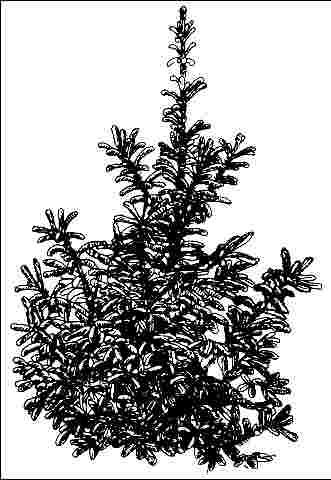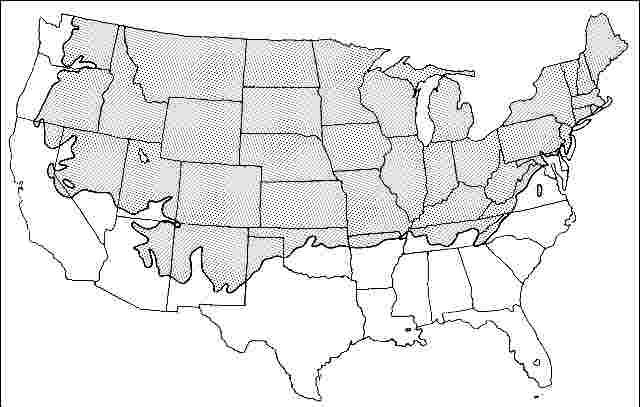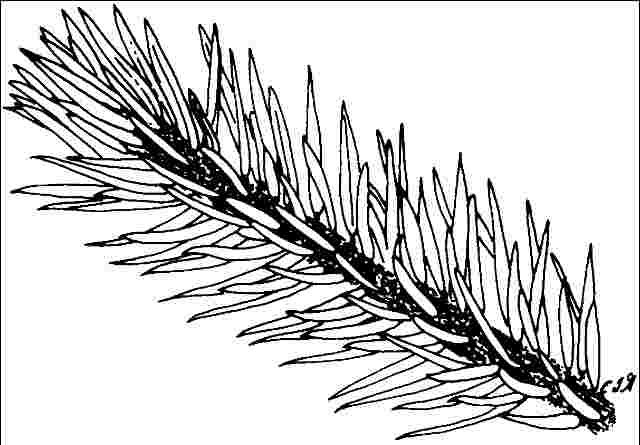Picea glauca: White Spruce1
Introduction
This North American native tree has a fairly broad, pyramidal silhouette when young but matures into a dense, 40 to 60-foot-tall column, 10 to 20 feet high. The short, silver-green needles densely clothe the upright branches making White Spruce ideally suited to use as a hedge or windbreak. Small, 1 to 2.5-inch-long, light brown, pendulous cones decorate the branches throughout the year. The new layers of purplish/grey bark have a soft, silvery sheen which add to the tree's attractiveness as a specimen planting.

General Information
Scientific name: Picea glauca
Pronunciation: PIE-see-uh GLAW-kuh
Common name(s): White Spruce
Family: Pinaceae
USDA hardiness zones: 2A through 6B (Fig. 2)
Origin: native to North America
Invasive potential: little invasive potential
Uses: specimen; screen; Christmas tree
Availability: somewhat available, may have to go out of the region to find the tree

Description
Height: 40 to 60 feet
Spread: 15 to 20 feet
Crown uniformity: symmetrical
Crown shape: pyramidal, columnar
Crown density: dense
Growth rate: moderate
Texture: fine
Foliage
Leaf arrangement: alternate (Fig. 3)
Leaf type: simple
Leaf margin: entire, terminal spine
Leaf shape: needle-like (filiform)
Leaf venation: parallel
Leaf type and persistence: needled evergreen, fragrant, evergreen
Leaf blade length: less than 2 inches
Leaf color: green, blue or blue-green
Fall color: no color change
Fall characteristic: not showy

Flower
Flower color: red, yellow
Flower characteristics: not showy
Fruit
Fruit shape: elongated, cone
Fruit length: 1 to 3 inches
Fruit covering: dry or hard
Fruit color: brown
Fruit characteristics: does not attract wildlife; not showy; fruit/leaves not a litter problem
Trunk and Branches
Trunk/bark/branches: branches droop; not showy; typically one trunk; thorns
Pruning requirement: little required
Breakage: resistant
Current year twig color: brown
Current year twig thickness: medium, thick
Wood specific gravity: 0.40
Culture
Light requirement: full sun, partial sun or partial shade
Soil tolerances: clay; sand; loam; acidic; slightly alkaline; well-drained
Drought tolerance: high
Aerosol salt tolerance: low
Other
Roots: not a problem
Winter interest: no
Outstanding tree: yes
Ozone sensitivity: tolerant
Verticillium wilt susceptibility: resistant
Pest resistance: sensitive to pests/diseases
Use and Management
Most often found on stream banks and lake shores, White Spruce should be grown in the landscape on moist or dry soils in full sun or partial shade. Trees which are well-established are quite tolerant of wind, heat, cold, and drought but can also tolerate wet soil for a period of time.
Propagation is by seed or cuttings.
The cultivar `Conica' is a 10 to 15-foot-high dwarf form with soft, blue/green needles and is ideal for container use, particularly at Christmastime.
Pests
Mites, aphids and bagworms are the most common pests.
Two gall commonly attack Spruce. Eastern Spruce gall adelgid forms pineapple like galls at the base of twigs. Galls caused by Cooley's Spruce gall adelgid look like miniature cones at the branch tips. The gall adelgids do not kill trees unless the infestation is heavy. A few galls on a large tree are not serious.
Bagworms make a sack by webbing needles together. Small numbers may be picked off by hand or use Bacillus thuringiensis .
Spruce budworm larvae feed on developing buds and young needles. The yellowish brown caterpillars are difficult to see.
The Spruce needle miner makes a small hole in the base of a needle then mines out the center. Dead needles are webbed together and can be found on infested twigs.
Pine needle scale is a white, elongated scale found feeding on the needles only. Populations would have to be quite high to cause major damage.
Spider mites can be problem in summer after hot dry weather. The small insects can't be readily seen with the naked eye. The first noticeable symptoms are yellowing of the oldest needles on infested branches. Close inspection with a magnifying glass will confirm the presence of the mites.
Sawfly larvae may feed on the needles. One infestation will usually not kill the tree.
Diseases
Several rust diseases attack Spruce but these are rarely seen. Infected needles turn yellow and drop off.


